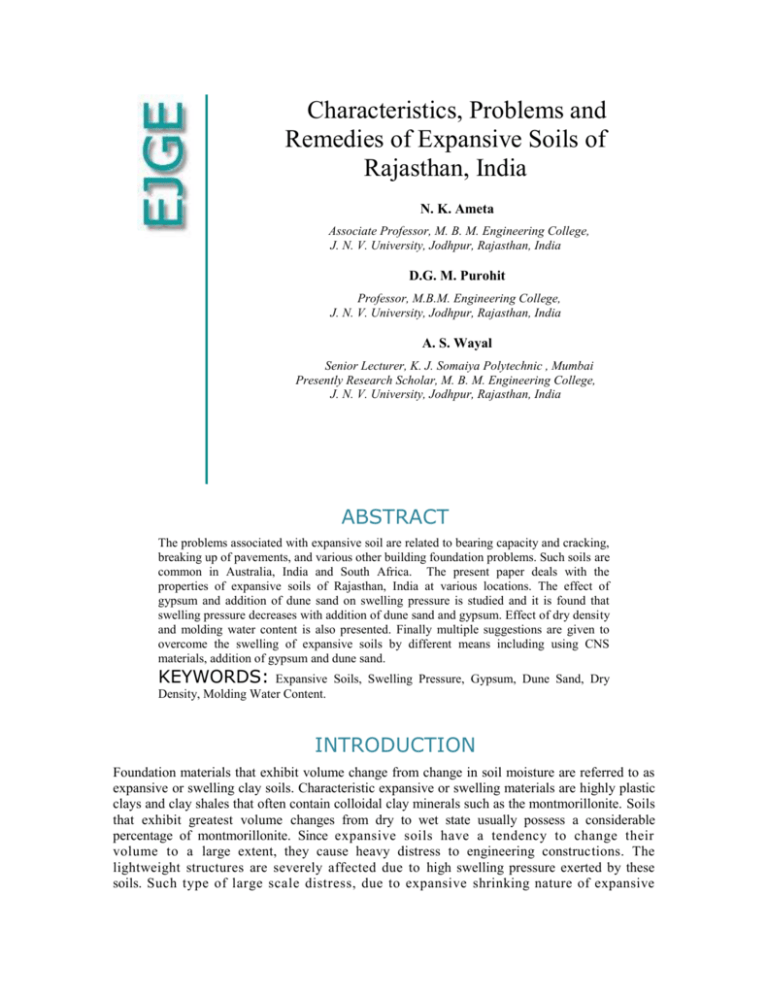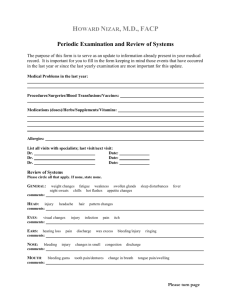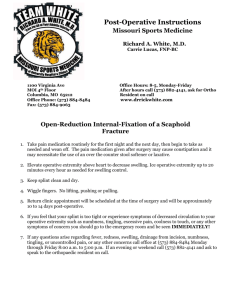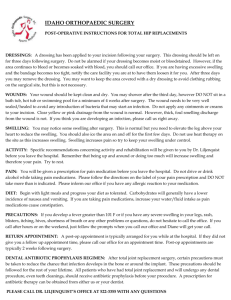Ppr0786 - Electronic Journal of Geotechnical Engineering
advertisement

Characteristics, Problems and Remedies of Expansive Soils of Rajasthan, India N. K. Ameta Associate Professor, M. B. M. Engineering College, J. N. V. University, Jodhpur, Rajasthan, India D.G. M. Purohit Professor, M.B.M. Engineering College, J. N. V. University, Jodhpur, Rajasthan, India A. S. Wayal Senior Lecturer, K. J. Somaiya Polytechnic , Mumbai Presently Research Scholar, M. B. M. Engineering College, J. N. V. University, Jodhpur, Rajasthan, India ABSTRACT The problems associated with expansive soil are related to bearing capacity and cracking, breaking up of pavements, and various other building foundation problems. Such soils are common in Australia, India and South Africa. The present paper deals with the properties of expansive soils of Rajasthan, India at various locations. The effect of gypsum and addition of dune sand on swelling pressure is studied and it is found that swelling pressure decreases with addition of dune sand and gypsum. Effect of dry density and molding water content is also presented. Finally multiple suggestions are given to overcome the swelling of expansive soils by different means including using CNS materials, addition of gypsum and dune sand. KEYWORDS: Expansive Soils, Swelling Pressure, Gypsum, Dune Sand, Dry Density, Molding Water Content. INTRODUCTION Foundation materials that exhibit volume change from change in soil moisture are referred to as expansive or swelling clay soils. Characteristic expansive or swelling materials are highly plastic clays and clay shales that often contain colloidal clay minerals such as the montmorillonite. Soils that exhibit greatest volume changes from dry to wet state usually possess a considerable percentage of montmorillonite. Since expansive soils have a tendency to change their volume to a large extent, they cause heavy distress to engineering constructions. The lightweight structures are severely affected due to high swelling pressure exerted by these soils. Such type of large scale distress, due to expansive shrinking nature of expansive soil, can be prevented by either obstructing the soil movement and reducing the swelling pressure of soil or making the structure sufficiently resistant to damage from soil movement. In Western Rajasthan, India previously it seems that only dune sand is present up to great depth or there is some sand stone etc. However, during construction of Rajasthan Canal (Presently Indira Gandhi Nahar) project, it was observed that bentonite is present below the dune sand or at depth when canal is in cutting. This causes swelling (i.e. volume change) and hence there are cracks in the lining of canal. Not only in Jaisalmer (Ramgarh, Pokhren, etc), swelling soil was observed but also in Barmer district, Pali district (Jetpur), Nagaur district, Jodhpur district, Bhopalgarh etc. Swelling soil is present. Many researchers have worked on expansive soils such as Jones & Holtz (1973), Chan (1975), Mathur (1995) and Pandey (1997). PROPERTIES OF SWELLING SOIL Due to the presence of imbalance electrical charge and cation exchange capacity produced by sodium-based montmorillonite the expansive bentonite soil swells. Replacing the sodium ions by inorganic compounds, which may produce such type of cation having less ion exchange capacity and also form a balanced electrical charge in soil structure, can reduce this expansion. Replacement of monovalent sodium by calcium ions may leads to a marked reduction in diffuse double layer thickness leading to decrease in liquid limit, plastics limits and swelling pressure. Keeping this aspect in view, an attempt has been made to study the alteration brought out by dune sand and gypsum mixture. Therefore, tests have been conducted on bentonite soil, obtained from different parts of Rajasthan, mixed with different percentage of dune sand and gypsum to study the effects of mixtures on swelling pressures of expansive soils. Also effect of molding water content and variation of densities are studied in view of change in swelling pressure. Few soil samples from various parts of Rajasthan were analyzed and various properties of these soils such as liquid limit, plastic limit, plasticity index, shrinkage limit, Grain size distribution, Unconfined compressive strength, shear properties and free swell index were analyzed in laboratory as per various IS (Indian Standards) codes. These are listed as Table 1. Table 1: Properties of various swelling soils Properties Locations of Swelling Soil under case study Jaisalmer Liquid limit % 190 Balotra Merta Pali (Jetpur) Kolayat (Bikaner) 85.0 105.0 100.0 50.0 Plastic limit % 45.0 44.0 50.0 50.0 23.0 Plastic Index 14.50 41.0 55.0 50.0 27.0 Shrinkage limit % 15.3 23.7 20.2 20.0 25.0 Sand % 3.0 2.0 5.0 7.0 12.0 % passing 75 micro sieve 97.0 98.0 95.0 93.0 88.0 Silt percentage 28.0 79.0 41.0 66.0 53.0 Clay % 69.0 19.0 54.0 27.0 35.0 Specific gravity 2.60 2.70 2.69 2.69 2.69 Unconfined compressive strength (kN/m2) 180.8 120.5 127.5 125.0 90.2 Cohesion Cu (kN/m2) 75.5 54.0 60.2 59.5 43.2 Angle of internal friction 21.0 25.2 22.0 22.2 28.3 Free swell index 690% 75% 108% 99% 58% Soil group CH CH CH CH CH Swelling soil of Jaisalmer district (Ramgarh), Balotra (Barmer district), and Kolayat were tested at different densities and various swelling pressure obtained are presented in Table 2. Table 2: Swelling pressure (kN/m2) of soils at various densities Density (gm/cm3) Jaisalmer Balotra Merta Pali Kolayat 1.45 195.0 30.2 43.7 45.2 21.3 1.55 270.0 50.7 65.5 67.3 41.2 1.65 325.0 81.0 100.2 103.5 61.3 1.75 375.0 110.2 120.3 123.5 75.5 1.85 395.0 120.7 129.7 131.7 85.2 1.95 442.0 135.3 145.3 147.2 101.3 The effect of molding water content on swelling pressure of expansive soil was investigated in the laboratory and the results obtained are listed in Table 3. Table 3: Effect of molding water content on swelling soils After addition of gypsum to the expansive soil of Jaisalmer, percentage reduction in swelling pressure of soil at various densities is presented in Figure1. Dry Molding Density water content (gm/cc) Locations → Swelling pressure (kN/m2) Jaisalmer Balotra Merta Pali Kolayat 1.65 4% 315.0 78.2 97.2 100.4 59.3 1.65 8% 307.0 75.7 95.3 98.3 55.4 1.65 12% 295.0 69.3 90.3 91.3 51.7 1.65 16% 280.0 61.7 81.3 85.4 47.8 1.65 20% --- 45.8 73.5 80.3 44.2 Figure 1: Reduction in swelling pressure with addition of Gypsum in expansive soil The variation of swelling pressure and reduction in % swell of Jaisalmer bentonite after addition of dune sand at different percentages is shown in Figure 2 and Figure 3. Figure 2: Variation of swelling pressure with addition of dune sand Figure 3: % Reduction of swelling Pressure with addition of dune sand RESULTS AND DISCUSSIONS Various soil samples obtained were tested to determine the swelling pressure at different density and different molding water content on examination of these Tables (2 and 3) it was observed that significant effect of swelling pressure with the change of dry density of the soil. Swelling pressure was increased from 195.0 to 442.0 kN/m2, 30.2 to 135.3 kN/m2, 43.7 to 145.3 kN/m2, 45.2 to 147.2 kN/m2 and 21.3 to 101.3 kN/m2 when density was increased from 1.45 to 1.95 g/cc for Jaisalmer, Balotra, Merta, Pali and Kolayat soil respectively. Similarly tests were conducted on dry density 1.65 g/cc and different molding water content, it was observed that due to increase in molding water content, the swelling pressure is reduced as 325.0 to 280.0 kN/m2, 81.0 to 45.8 kN/m2, 100.2 to 73.7 kN/m2, 103.5 to 80.3 kN/m2 and 61.3 to 44.2 kN/m2 when molding water content changed from 0% to 20%. The difference of swelling pressure is high at initial level. As the initial water content increase for various soil specimens having the same dry unit weight, the initial degree of saturation will also increase and the affinity of the soil to absorb water will decrease. SUGGESTED REMEDIES FOR SWELLING SOIL The swelling soil causes due to its expansive nature with water cracks are formed in buildings, canal lining etc. various suggestions to overcome the problem is as under: Provide CNS layer. Detailed study of CNS depth, layer thickness properties of CNS are carried out and published by Dr. Katti (1972, 1979). It is a great problem now a day to locate the CNS material at nearby site and hence it is very costly some times to transport the natural CNS material. Some percentage of clay, sand and the existing swelling soil may be used as CNS material. Provide under-reamed piled foundation. Provide slotted footing so that this may reduce the swelling pressure. Addition of gypsum will reduce the swelling pressure. Limit the foundation depth if swelling soil is at some depth so that distance between foundation and swelling soil will be more and as the distance is more there are less chances of cracks in building. Take effective measures to maintain moisture equilibrium in foundation soil. Add dune sand in the existing swelling soil. CONCLUSIONS Swelling soils are present in various parts of Rajasthan. Swelling pressures, liquid limit plastic limit, shrinkage limit etc. are different at each site and there is no correlation of properties of each site. Swelling pressure increases with increase in dry density and decreases with increase in molding water content. Swelling pressure also decreases due to addition of gypsum and dune sand. Various remedial measures are presented in the paper to overcome the problem of swelling pressure. REFERENCES 1. Chan R.H. (1975) “Foundation on Expansive Soil,” 2nd edition. Elsevier Scientific Publishing Company, New York. 2. Chen, F. H. (1988) "The Basic Physical Properties of Expansive Soils", Proc. 3`d on Expansive Soils, Haifa, Israel. Int. Conf. 3. Jones, D.E J., and Holtz, W.G. (1973) “Expansive Soils – The hidden Disaster,” Civil Engineering, Vol.43, Nov. 8. 4. Katti, R.K. (1972) “Mechanics of Swelling Soil Media - A Discrete Practical Approach” Keynote address symposium on strength and deformation behaviour of soil, Indian Geotechnical Society, Mysore Centre, Banglore. 5. Katti, R.K. (1979) "Search for Solutions to Problems in Black Cotton Soils". Indian Geotechnical Journal, LG.S. Vol. 9, No. 1 6. Mathur, A.K. (1995) “Study of Gypsum on the Swelling Pressure Characteristics of Bentonite,” M.E. Thesis, J. N.V. University, Jodhpur 7. Panday, R.K. (1997) “A Study of Effect of Addition of Dune Sand on the Swelling Characteristics of expansive clay,” M.E. Thesis, J. N. V. University, Jodhpur © 2007 ejge






